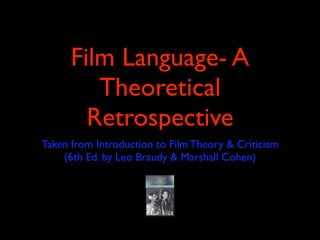
Film Language
- 1. Film Language- A Theoretical Retrospective Taken from Introduction to Film Theory & Criticism (6th Ed. by Leo Braudy & Marshall Cohen)
- 2. D.W. Griffith • Most suggest that it was Griffith who invented ‘montage.’ • Via ‘intercutting’ seemingly unrelated shots or through juxtaposing the close-up shot, followed by panoramic long-shots. This started to create the ‘language’ of film.
- 3. Sergei Eisenstein- ‘Collision Montage’ • Defined his montage as a collision or conflict between one shot and its successor. • Happy/sad, dark/light, slow/fast, large/small, left/right • ‘Collision’ as expression of Marxist principles...
- 4. Vsevolod Pudovkin- ‘Linkage Montage • Wanted to link shots together, each building on the last in communicating meaning. • His work created a ‘deliberate, calmer pace.’
- 5. Sound- Andre Bazin • Eisenstein rejected dialogue as incompatible with the principles of montage. • Film theorist Bazin disagreed, seeing dialogue as returning film to the rightful path, from which silence and montage diverted it. • ‘The film image ought to reveal reality whole, not cut it into tiny bits.’
- 6. Bazin- ‘Mise en scene’ • Bazin foregrounded the importance of composition (composing each shot within the film) with ‘staging the action’ and has come to be known as mise en scene. • Indeed, Bazin reclaims the work of Von Stroheim, F.W. Murnau and Flaherty (all working silent film) as challenging the montage tradition with content imagery.
- 7. Bazin- Evolving Form • Bazin preferred to reject the art of Russian Formalists and German Expressionists in favour of ‘analytic editing.’ He considered the shot/reverse shot to be an important innovation. • This in itself was superseded by ‘depth of field.’ (See Citizen Kane) This allowed for greater realism and more active viewer engagement, exploring the composition.
- 8. Colin Henderson • Agreed that the ‘long-take’ was crucial but preferred the long, slow tracking shots which avoided depth of field as can be seen in Godard’s work. • Henderson claimed this was an ideological composition to show the world as a flat, 2- dimensional space, open to criticism and examination.
- 9. Structuralism • With the rise of structuralism and semiotics in the late 60s and 70s, those such as Christian Metz & Umberto Eco made use of linguistic traditions (such as those by Ferdinand de Saussure, Todorov, Barthes, Levi-Strauss etc) to use a scientific base for the deconstruction of the text.
- 10. The Science of Signs • Metz claimed that film shots were more than just the equivalent of a spoken word but were actually akin to whole sentences and that when seen as part of an entire film represent much more. • Only when organised into ‘repeatable, recognisable codes’ do they become discourse and capable of telling a story.’
- 11. ‘Grande Syntagmatique’ • Metz wanted to apply the semiotics of denotation/connotation in a scientific manner to the study of narrative. (Succession, priority, temporal breaks & spatial continuity) • For Metz, ‘film does not simply reveal reality; it describes it in a language whose features we are only beginning to understand.’
- 12. Althusser & Lacan • Marxist theory which suggested the relationship between signifier and signified was arbitrary (culturally relative...e.g. Biased) • Claimed instead that film texts are to be ‘read’ and reading that requires our understanding of cinematic conventions and ideological biases.
- 13. Stephen Heath • ‘...the match of film and world, is a matter of representation, and representation is in turn a matter of discourse...(I)n this sense at least, film is a series of languages, a history of codes.’
- 14. Stephen Prince- ‘Icons’ • Prince argued against this, suggesting iconography ‘resemble reality’ and that this skill is shared cross-culturally. This kind of visual literacy (as it became to be known later) cannot be explained by linguistic meaning.
- 15. Daniel Dayan- Reclaims The Shot/Reverse Shot • Borrowed an expression from Oudart, namely ‘the absent one.’ He applied this to the shot/reverse shot by suggesting that each shot can only be understood by seeing the next shot. • The spectator therefore loses a sense of the present as there is always an ‘absent one’ in each shot.
- 16. Nick Browne- ‘The Implied Narrator’ • Considers the authority of the narrator... • ‘The way in which we as spectators, are implicated in the action is as much a matter of our position with respect to the unfolding of events as it is in their representation from a point of space.’
- 17. ‘Suture’ • Both Devan & Brown relate this debate to the ideological position or suture created by the point of view shot. However, Brown considered that we are not asked to share the ideological position of the protagonist just because we inhabit this space within the world of the film.
